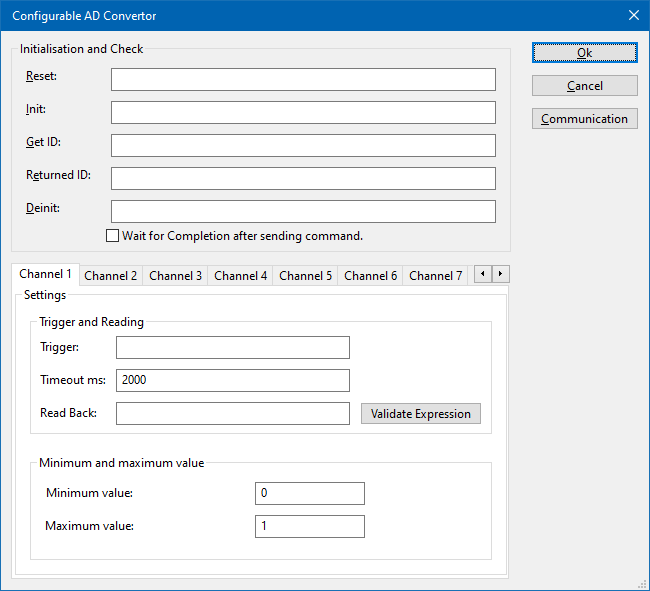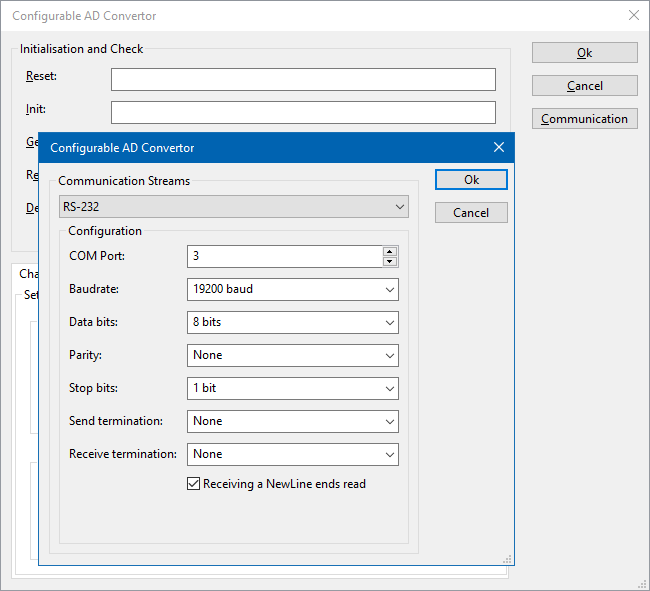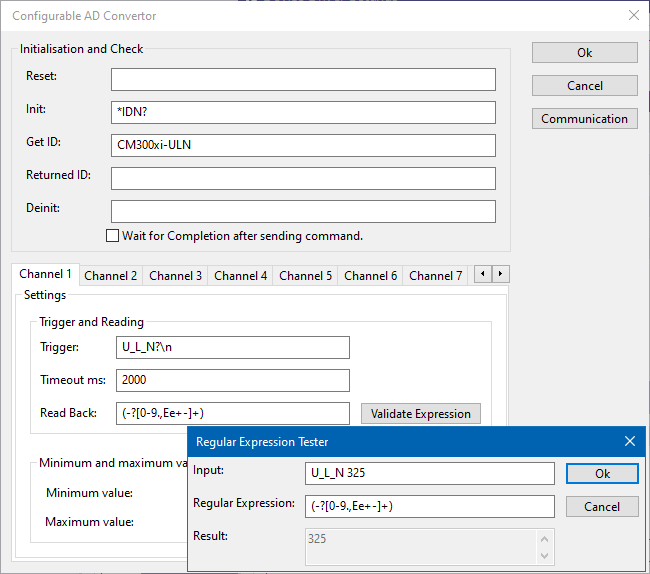RadiMation Application Note 114: Difference between revisions
No edit summary |
No edit summary |
||
| Line 25: | Line 25: | ||
== 1.1 Specify the communication type == | == 1.1 Specify the communication type == | ||
First the communication type must be configured | First the communication type must be configured. | ||
Multiple communication types can be selected. | |||
<div style="text-align: left; direction: ltr; margin-left: 2em;">[[File:ConfigureCommunication.png]]</div> | <div style="text-align: left; direction: ltr; margin-left: 2em;">[[File:ConfigureCommunication.png]]</div> | ||
| Line 33: | Line 34: | ||
{{ScreenElementDescriptionStart}} | {{ScreenElementDescriptionStart}} | ||
{{ScreenElementDescription|Reset|The reset code that needs to be send to device. When left blank no command will be send.}} | {{ScreenElementDescription|Reset|The reset code that needs to be send to device. When left blank no command will be send.}} | ||
{{ScreenElementDescription|Init|The | {{ScreenElementDescription|Init|The command that is send to initialize the configured device. When left blank no command will be send.}} | ||
{{ScreenElementDescription|Get Id|The | {{ScreenElementDescription|Get Id|The command that is send to retrieve the ID of the device. This is used to check if the device is connected. A common used [[SCPI]] command is *IDN?. When left blank no command will be send.}} | ||
{{ScreenElementDescription|Returned ID|The identifier is used to check if the correct device driver is selected and the device is connected. Leaving this blank will skip the device check.}} | |||
{{ScreenElementDescription|Deinit|Specifies the command that is send when the device is no longer in use. Leaving this blank will keep the device in its last state after controlling it.}} | |||
A checkmark can be enabled so RadiMation will wait for all the commands to complete. This is done by sending [[SCPI]] command *OPC? to the device. | |||
{{ScreenElementDescriptionEnd}} | {{ScreenElementDescriptionEnd}} | ||
== 1.3 Configure the data readout of the device == | |||
AD convertors can have multiple channels on which AD values could be read. | |||
For each AD channel, individual commands can be set. | |||
==== Trigger and Reading ==== | |||
{{ScreenElementDescription|Trigger|A trigger command can be specified to request a measurement from the device. A common used [[SCPI]] is *TRG. When left blank no command will be send.}} | {{ScreenElementDescription|Trigger|A trigger command can be specified to request a measurement from the device. A common used [[SCPI]] is *TRG. When left blank no command will be send.}} | ||
| Line 60: | Line 70: | ||
== 1. | == 1.5 Examples == | ||
{| class="Regex example table" | {| class="Regex example table" | ||
Revision as of 12:54, 6 October 2016
How to measure data from the EUT using the Configurable AD Convertor device driver[edit]
This Application Note explains how a configurable AD convertor can be used to monitor an EUT. With the AD convertor, any type of signal can be monitored and plotted within RadiMation during a test.
- First the AD convertor must be configured so values can be read within RadiMation.
- Second the value must be plotted using the correct unit types.
1 Configuring the AD convertor[edit]
1.1 Specify the communication type[edit]
First the communication type must be configured. Multiple communication types can be selected.
1.2 Configure the initialization of the device[edit]
| The reset code that needs to be send to device. When left blank no command will be send. |
| The command that is send to initialize the configured device. When left blank no command will be send. |
| The command that is send to retrieve the ID of the device. This is used to check if the device is connected. A common used SCPI command is *IDN?. When left blank no command will be send. |
| The identifier is used to check if the correct device driver is selected and the device is connected. Leaving this blank will skip the device check. |
| Specifies the command that is send when the device is no longer in use. Leaving this blank will keep the device in its last state after controlling it. |
A checkmark can be enabled so RadiMation will wait for all the commands to complete. This is done by sending SCPI command *OPC? to the device.
1.3 Configure the data readout of the device[edit]
AD convertors can have multiple channels on which AD values could be read. For each AD channel, individual commands can be set.
Trigger and Reading[edit]
| A trigger command can be specified to request a measurement from the device. A common used SCPI is *TRG. When left blank no command will be send. |
| Different devices return different messages with measurement values. The configurable AD convertor only need the numeric value of the measurement message. There for, a regular expressions can be set in the Read Back.
A good regular expression for finding the first number in scientific notation in a text is: ([+-]?[0-9]*\.?[0-9]+([eE][+-]?[0-9]+)?) For more possibilities see the example section. |
Minimum and maximum value[edit]
Minimum and maximum can be set to limit the measured value. And to calculate the measured value to a specific unit.
| The lowest value that can be measured with this device. The value must be the same as filled in the EUT window. |
| The highest value that can be measured with this device. The value must be the same as filled in the EUT window. |
1.5 Examples[edit]
Received information
|
Regex
|
RadiMation Readout
|
Note
|
|---|---|---|---|
| U_L_N 325 | (-?[0-9.,Ee-]+)
|
325
|
Takes the first number.
|
| I_L1;12.34 | ;(-?[0-9.,Ee-]+)
|
12.34
|
Takes the first number after ";".
|
| THD_U_L1;;14,5 | ;;(-?[0-9.,Ee-]+)
|
14.5
|
Takes the first number after ";;".
|
| AC_FREQ;Channel1;1.23E3 | ;*;(-?[0-9.,Ee-]+)
|
1230
|
Takes the first number after the appearance of a second ";".
|
Read backs can always be tested trough the "Validate Expression tool"


